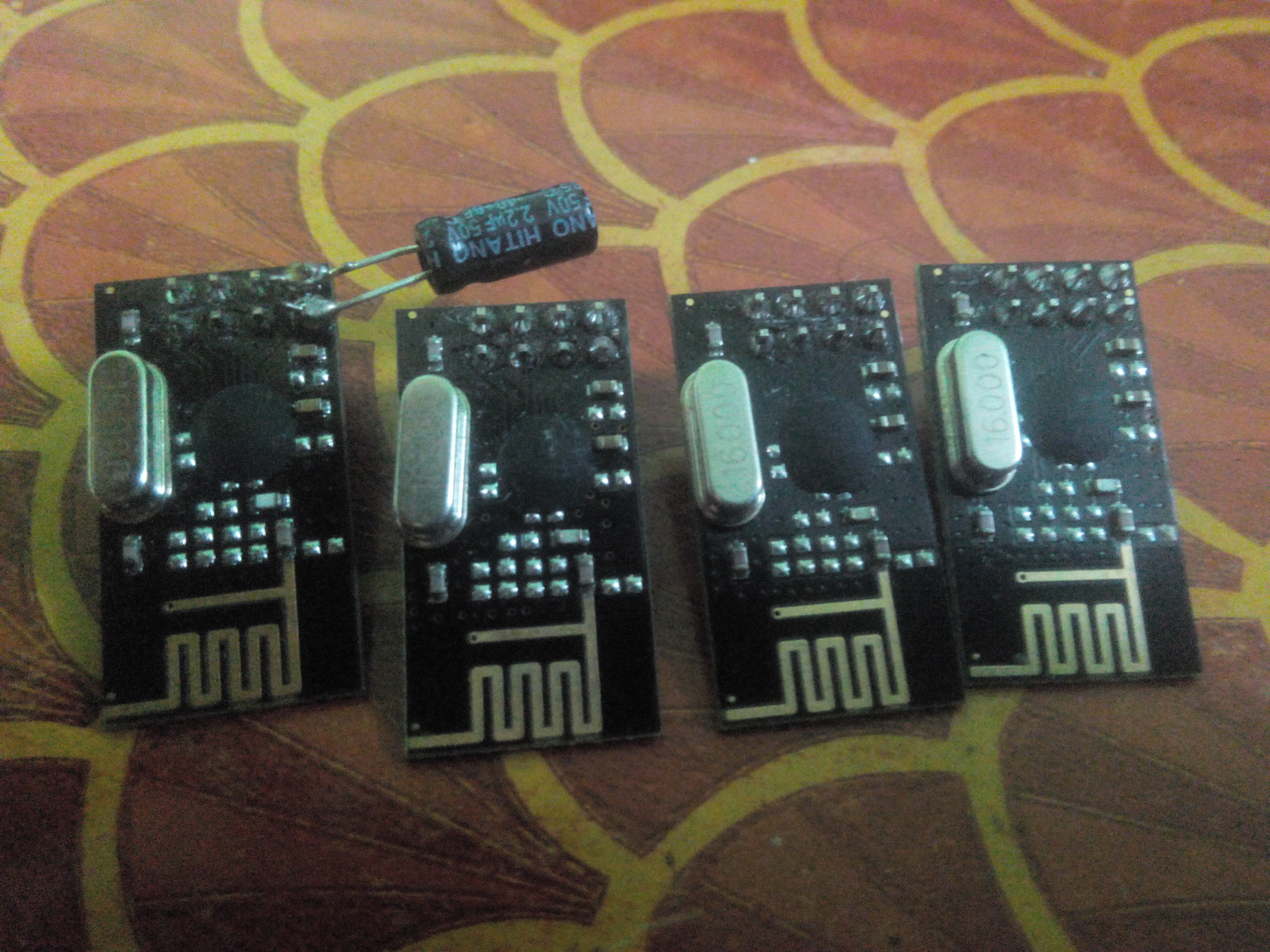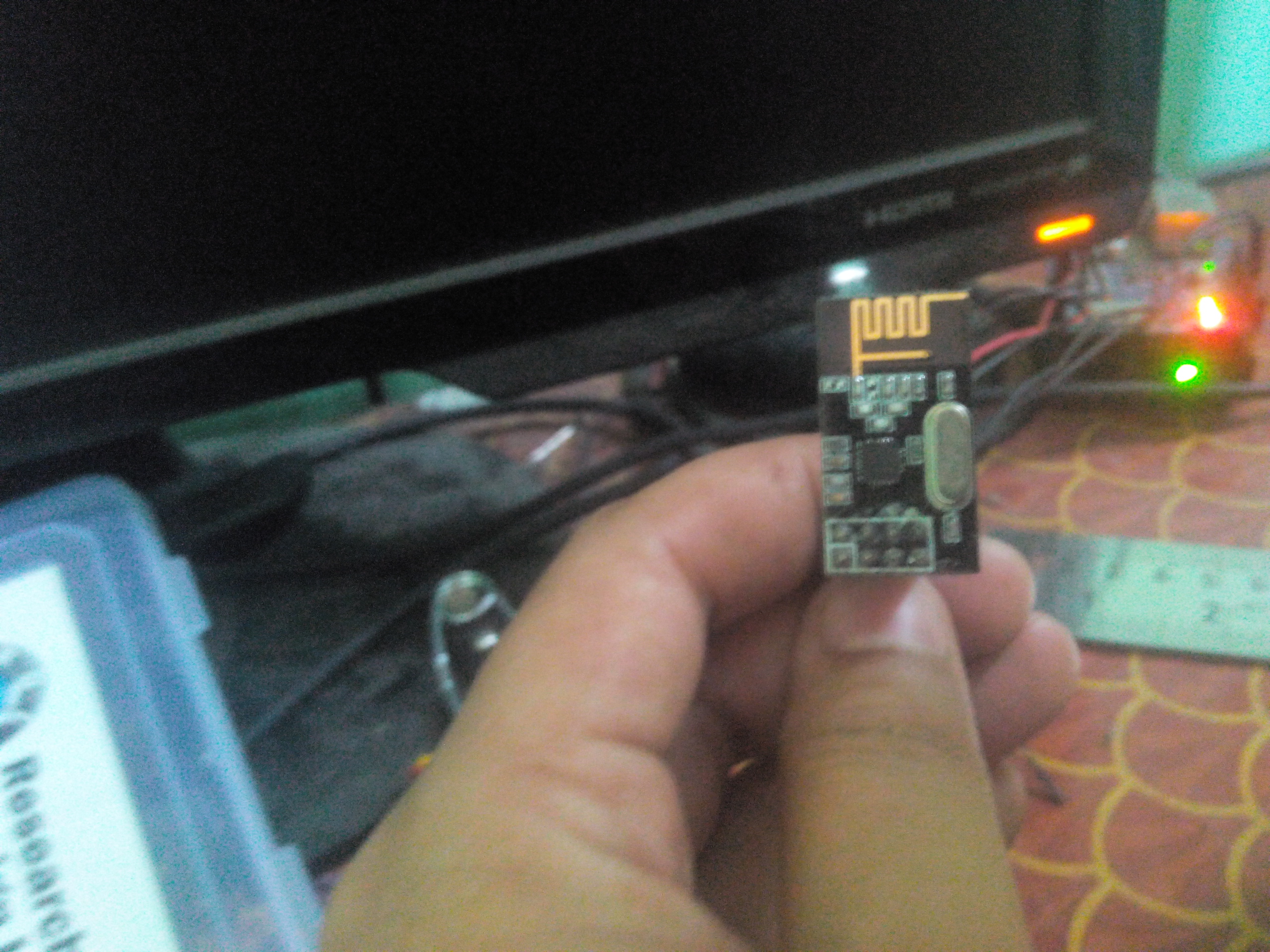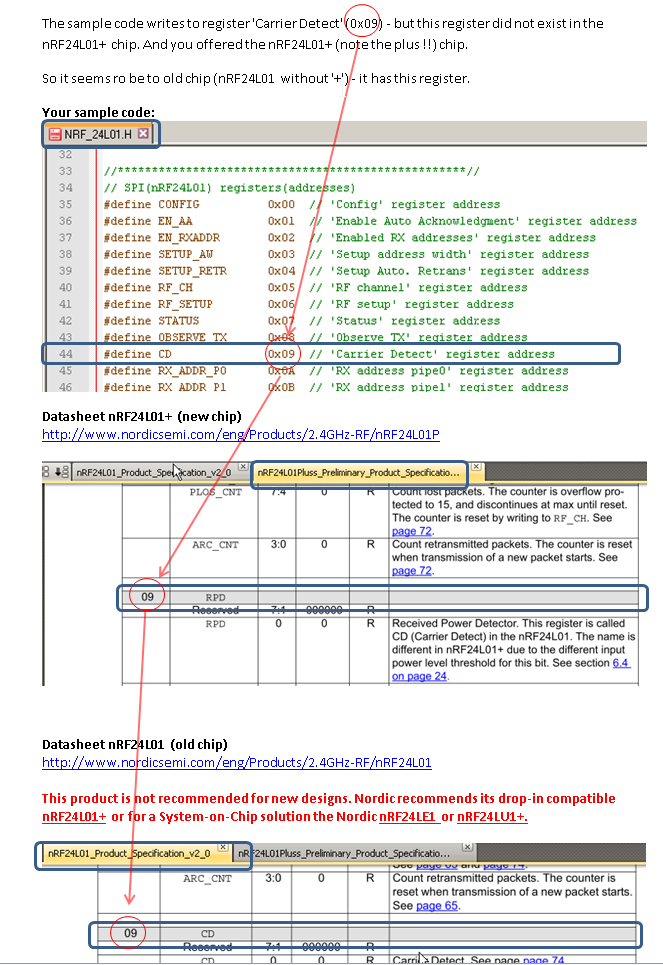We are mostly using fake nRF24L01+'s, but worse fakes are emerging.
-
(see new links at end of this post)
(see earlier thread about nRF24l01(no plus) substitutes - not quite the same topic as this thread but related; from a comment below)
(see newer thread on finding the best nRF24L01+)
First off, it appears that most of the cheap nRF's have been fakes (not genuine Nordic chips). There is some indication that they may use somewhat more power and be somewhat less sensitive, than the real thing - and may be more sensitive to power supplies. Not a big problem, since that level of performance is what we're used to (many of us have probably never used a Nordic nRF24L01+).
However, there are even cheaper fakes hitting the market, with inferior specs and outright incompatibilities. In particular, the Si24R1 got the ACK bit inverted (following an error in the datasheet), so it's incompatible with the real nRF24L01+ (and good clones) in ESB mode. (The Si24R1 is often falsely labeled as nRF24L01+). In some cases you can build a network of such variants that work OK together, but a node with the other chip won't work right (at least in ESB mode). There are several other clones too, with whatever changes they happen to have.
And clone chips weren't enough, there is a new cheap module with the chip under an epoxy blob (no biggee per se), which also omits a number of the passive components in the Nordic reference design used by most modules (caps, resistors, inductors). This seems to have problems with the ACK bit due to the chip itself (see avove), but due to module design also probably has reduced actual transmit power, less power filtering, etc. (And would even if it had a good chip in it).
I'm mentioning this because chips that don't work right in some circumstances (depending on which features are used), or which are electrically marginal and thus have intermittent problems, can lead to serious hair loss. And this is probably going to be an increasing problem in our niche, as our vendors switch to the cheapest suppliers.
If you are having odd problems, sometimes it may be that you have one of the clone chips or cost reduced modules.
Perhaps we need to find a good supplier who knows we want only "genuine" high quality clones :-) and who will not suddenly switch to less compatible ones. In the DIY christmas lighting community many people patronize one particular Ali Express vendor (Ray Wu) who has an overall good reputation within that community, who is aware that many people in that community communicate frequently, and who wants to keep a good reputation. He gets enough volume from that community to have incentive to keep up his quality and to fix problems (at least in relative terms among Ali Express vendors).
Some background:
http://hackaday.com/2015/02/23/nordic-nrf24l01-real-vs-fake/
http://ncrmnt.org/wp/2015/03/13/how-do-i-cost-optimize-nrf24l01/
Updates:
List of related chips (if not mislabeled as Nordic these would be clones, derivatives or compatibles, not fakes per se, but I'll list them here as some fakes may really be one of these chips or closer to it): http://sigrok.org/wiki/Protocol_decoder:Nrf24l01
Info about Si24R01 and power: https://github.com/solarkennedy/equail/tree/master/Libraries/RF24
-
The other thing we might do is get into the habit of immediately quality testing new batches of nRF24L01+ modules.
First thing is just to see if it works in ESB mode with our existing chips, and that it works on all channels (some clones are reported to be marginal at the ends of the band).
I wonder how else to test RF quality. Maybe have a standard test location - like test it from a particular place in the garage against a known existing node, where we know that our old nodes would work but maybe barely. If the new batch fails from that location, we won't waste too much time with weak chips confusing our debugging in the middle of a more complex project.
-
I am a victim of those fake clones. As I was just starting with nrf, it took me 3 days of debugging to figure out that issue is with the RF module itself, it wont send ACK, altogether.I bought 5 of then for $4.

The other one I am using is little better but its not a nrf+, I had to disable the isPvariant(), check to solve the check wires problem.

-
Unsettling stuff. Thanks for the warning. Makes me wonder exactly how advanced the Chinese clone factories are, I mean, if they are making this relatively advanced IC, is any IC safe from China? Granted that only high volume stuff is worth cloning.
Another reason to move away from the NRF24 if opportunity arises. Genuine (?) RFM69 are looking better and better.
-
I am a victim of those fake clones. As I was just starting with nrf, it took me 3 days of debugging to figure out that issue is with the RF module itself, it wont send ACK, altogether.I bought 5 of then for $4.

The other one I am using is little better but its not a nrf+, I had to disable the isPvariant(), check to solve the check wires problem.

-
Yes, some might be clones of the nRF24L01 (no +). Others have bugs.
And at least some modules with epoxy blobs rather than chips may also be missing some of the normal external passive components leading to reduced performance - in addition to questionable chips per se. This is almost worse for our sanity - being flakey rather than outright failing some digital aspect (like ESB) 100% of the time.
One commenter in one of the above referenced threads mentioned having one module which seemed unusually tolerant of the power supply quality - which he believed was a genuine Nordic chip. Maybe the PS issues we've all adapted to are largely due to our using clones (even the relatively good clones).
-
I am a victim of those fake clones. As I was just starting with nrf, it took me 3 days of debugging to figure out that issue is with the RF module itself, it wont send ACK, altogether.I bought 5 of then for $4.

The other one I am using is little better but its not a nrf+, I had to disable the isPvariant(), check to solve the check wires problem.

@mainali said:
I am a victim of those fake clones.
Well said. We've grown used to the quality clones, now there are "fake" clones on the market.
Sort of like cheap cheeses. In the US there used to be "natural" cheese, and "pasturized process" cheese (like "American cheese", a sad thing to have named after your nation). Then there was a brand of semi-soft block cheese called "Velveeta" which was labeled as "pasturized process cheese food". And some off-brand variants of that were labeled "imitation pasturized process cheese food". (These were all legal distinctions based on US Gov't standards, and the terminology has since changed).
So our nRF modules started out at "pasturized process cheese", and now there's "imitation pasturized process cheese food" entering the market - without such honest labeling.
-
Emailed my contact at Nordic about this a month ago.
There are unfortunately little they can do about the problem. There is almost a zero cost to open an Aliexpress shop and there the chinese goverment/Alibaba does not care enough.
http://resources.alibaba.com/topic/801220532/What_to_do_if_you_ve_received_fake_products.htm
-
Probably we could open a permanent thread where we can post our experiences with different aliexpress shops regarding nrf24l01+?
Is there a chance to write a short arduino program to check the identity of the nrf chip used? Then we could check the ones we receive and put this experience also in the above mentioned thread?
-
Ran the nRF24 GettingStarted and got this from two different nRF24's
Standard nRF24L01+
STATUS = 0x0e RX_DR=0 TX_DS=0 MAX_RT=0 RX_P_NO=7 TX_FULL=0
RX_ADDR_P0-1 = 0xa8a8e1fc62 0xf0f0f0f0d2
RX_ADDR_P2-5 = 0xff 0xc4 0xc5 0xc6
TX_ADDR = 0xa8a8e1fc00
RX_PW_P0-6 = 0x20 0x20 0x20 0x00 0x00 0x00
EN_AA = 0x3b
EN_RXADDR = 0x07
RF_CH = 0x4c
RF_SETUP = 0x07
CONFIG = 0x0f
DYNPD/FEATURE = 0x00 0x06
Data Rate = 1MBPS
Model = nRF24L01+
CRC Length = 16 bits
PA Power = PA_HIGHnRF24L01+ with Antenna
STATUS = 0x0e RX_DR=0 TX_DS=0 MAX_RT=0 RX_P_NO=7 TX_FULL=0
RX_ADDR_P0-1 = 0xe7e7e7e7e7 0xf0f0f0f0d2
RX_ADDR_P2-5 = 0xc3 0xc4 0xc5 0xc6
TX_ADDR = 0xe7e7e7e7e7
RX_PW_P0-6 = 0x00 0x20 0x00 0x00 0x00 0x00
EN_AA = 0x3f
EN_RXADDR = 0x03
RF_CH = 0x4c
RF_SETUP = 0x07
CONFIG = 0x0f
DYNPD/FEATURE = 0x00 0x00
Data Rate = 1MBPS
Model = nRF24L01+
CRC Length = 16 bits
PA Power = PA_HIGHThe one with antenna's adresse looks kind of "strange", but don't know if we can read anything out of this ????
-
Probably we could open a permanent thread where we can post our experiences with different aliexpress shops regarding nrf24l01+?
Is there a chance to write a short arduino program to check the identity of the nrf chip used? Then we could check the ones we receive and put this experience also in the above mentioned thread?
@phil83 said:
Probably we could open a permanent thread where we can post our experiences with different aliexpress shops regarding nrf24l01+?
I'd be interested to see a list of "good" sellers from aliexpress and not just for the radios. It seems like the store links just point to the cheapest one with free shipping some times. I haven't bought enough stuff to get burnt (7 orders of which 2 have come in and the rest should be in a week or 2) but it is one of the things that keeps me wary.
-
I just used the GettingStarted and got the following reply from a nrf24l01+ with antenna:
RF24/examples/GettingStarted/
ROLE: Pong back
*** PRESS 'T' to begin transmitting to the other node
STATUS = 0x0e RX_DR=0 TX_DS=0 MAX_RT=0 RX_P_NO=7 TX_FULL=0
RX_ADDR_P0-1 x00 = 0xe7e7e7e7e7 0xf0f0f0f0d2
RX_ADDR_P2-5 x00 = 0xc3 0xc4 0xc5 0xc6
TX_ADDR = 0xe7e7e7e7e7
RX_PW_P0-6 x00 = 0x00 0x20 0x00 0x00 0x00 0x00
EN_AA = 0x3f
EN_RXADDR x00 = 0x03
RF_CH = 0x4c
RF_SETUP x00 = 0x07
CONFIG = 0x0f
DYNPD/FEATURE x00 = 0x00 0x00
Data Rate = 1MBPS
Model = nRF24L01+
CRC Length = 16 bits
PA Power = PA_HIGHSo it's the same like @Magiske.
-
This is the first time I'm putting anything here. I also have been developing a C based library for one of the NRF24L01 (no plus) devices.. I used a Stellaris Launchpad to interface with the chip. Eventhough most of the functionality work correctly I saw the CD (Carrier Detect) is not functioning properly. Once it is high it is always high. To make it low I had to flush the RX buffer. It is really strange. I bought my sensors from e-Bay. So they must be clones :D. Can someone try this CD thing and see whether it is working properly?
-
Has anyone here found a good vendor for modules that use genuine Nordic NRF24L01+ chips?
-
You could buy your modules from Itead. They have promised us to only source genuine Nordic chips. They are a little higher in price/shipping but you could also take the opportunity to buy a MySensors Micro board to support the project :)
The ebay/aliexpress shops is a bit of a chance-taking as they might switch sourcing partner at any time.

